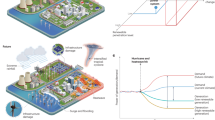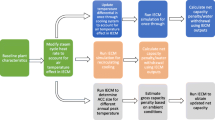Abstract
Large power transformers (LPTs) are critical yet vulnerable components of the power grid. More frequent and intense heat waves or high temperatures can degrade their operational lifetime and increase the risk of premature failure. Without adequate preparedness, a widespread situation could ultimately lead to prolonged grid disruption and incur excessive economic costs. Here, we investigate the potential impact of climate warming and corresponding shifts in summertime “hot days” on a selected LPT located in the Northeast United States. We apply an analogue method, which detects the occurrence of hot days based on the salient, associated large-scale atmospheric conditions, to assess the risk of future change in their occurrence. Compared with the more conventional approach that relies on climate model-simulated daily maximum temperature, the analogue method produces model medians of late twentieth century hot day frequency that are more consistent with observation and have stronger inter-model consensus. Under the climate warming scenarios, multi-model medians of both model daily maximum temperature and the analogue method indicate strong decadal increases in hot day frequency by the late twenty-first century, but the analogue method improves model consensus considerably. The decrease of transformer lifetime with temperature increase is further assessed. The improved inter-model consensus of the analogue method is viewed as a promising step toward providing actionable information for a more stable, reliable, and environmentally responsible national grid.



Similar content being viewed by others
References
Askari MT, Kadir MZAA, Ahmad WFW, Izadi M (2009) Investigate the effect of variations of ambient temperature on HST of transformer. 2009 I.E. Student Conference on Research and Development (SCOReD), UPM Serdang, pp 363–367
Bosilovich MG, Lucchesi R, Suarez M (2016) MERRA-2: file specification. GMAO office note no. 9 (Version 1.1), 73 pp.
Davis M, Clemmer S (2014) Power failure: how climate change puts our electricity at risk and what we can do. Union of Concerned Scientists
Eto JH (2004) Blackout 2003: final report on the August 14, 2003 blackout in the United States and Canada: causes and recommendations. US Department of Energy, Washington
Federal Energy Regulatory Commission (2003) Final report on price manipulation in Western markets. Docket No. PA02-2-000, US Department of Energy, Washington, DC
Fu W, McCalley JD, Vittal V (2001) Risk assessment for transformer loading. IEEE Trans Power Syst 16:346–353
Gao X, Schlosser CA, Xie P, Monier E, Entekhabi D (2014) An analogue approach to identify heavy precipitation events: evaluation and application to CMIP5 climate models in the United States. J Clim 27:5941–5963
Gao X, Schlosser CA, O’Gorman PA, Monier E, Entekhabi D (2017) Twenty-first-century changes in U.S. regional heavy precipitation frequency based on resolved atmospheric patterns. J Clim 30:2501–2521
Godina R, Rodrigues EM, Matias JC, Catalao JP (2015) Effect of loads and other key factors on oil-transformer ageing: sustainability benefits and challenges. Energies 8:12147–12186
Grotjahn R (2011) Identifying extreme hottest days from large scale upper air data: a pilot scheme to find California Central Valley summertime maximum surface temperatures. Clim Dyn 37:587–604
Grotjahn R (2013) Ability of CCSM4 to simulate California extreme heat conditions from evaluating simulations of the associated large scale upper air pattern. Clim Dyn 41:1187–1197
Grotjahn R, Faure G (2008) Composite predictor maps of extraordinary weather events in the Sacramento California region. Weather Forecast 23:313–335
Hurricane Sandy Rebuilding Task Force (2013) Hurricane Sandy rebuilding strategy: stronger communities, a resilient region. U.S. Department of Housing and Urban Development
IEEE (2012) IEEE standard test procedure for thermal evaluation of insulation systems for liquid-Immersed distribution and power transformers-Redline. IEEE Std C57.100-2011 pp. 1–55
IPCC (2013) Summary for policymakers. In: Stocker TF et al (eds) Climate change 2013: the physical science basis. Cambridge University Press, Cambridge
Kharin VV, Zwiers FW, Zhang X, Hegerl GC (2007) Changes in temperature and precipitation extremes in the IPCC ensemble of global coupled model simulations. J Clim 20:1419–1444
Kharin VV, Zwiers FW, Zhang X, Wehner M (2013) Changes in temperature and precipitation extremes in the CMIP5 ensemble. Clim Chang 119:345–357
Landy M (2007) A failure of initiative: the final report of the select bipartisan committee to investigate the preparation for and response to hurricane Katrina. Publius J Federalism 38:152–165
Lau N-C, Nath MJ (2012) A model study of heat waves over North America: meteorological aspects and projections for the twenty-first century. J Clim 25:4761–4784
Li X, Mazur RW, Allen DR, Swatek DR (2005) Specifying transformer winter and summer peak-load limits. IEEE Trans Power Delivery 20:185–190
Meehl G, Tebaldi C (2004) More intense, more frequent, and longer lasting heat waves in the 21st century. Science 305:994–997
Melillo JM, Richmond TC, Yohe GW (2014) Climate change impacts in the United States: Third National Climate Assessment. U.S. Global Change Research Program
Menne MJ, Durre I, Vose RS, Gleason BE, Houston TG (2012) An overview of the global historical climatology network-daily database. J Atmos Ocean Technol 29:897–910
Parfomak PW (2014) Physical security of the U.S. power grid: high-voltage transformer substations. Congressional Research Service
Pederson P, Dudenhoeffer D, Hartley S, Permann M (2006) Critical infrastructure interdependency modeling: a survey of US and international research. Idaho National Laboratory pp. 1–20
Pletka R, Khangura J, Rawlins A, Waldren E, Wilson D (2014) Capital costs for transmission and substations: updated recommendations for WECC transmission expansion planning, Black and Veatch PROJECT NO. 181374
Russo S et al (2014) Magnitude of extreme heat waves in present climate and their projection in a warming world. J Geophys Res Atmos 119:12,500–12,512
Sathaye J et al. (2011) Estimating risk to California energy infrastructure from projected climate change. LBNL-4967E
Schoetter R, Cattiaux J, Douville H (2015) Changes of western European heat wave characteristics projected by the CMIP5 ensemble. Clim Dyn 45:1601–1616
Sillmann J, Kharin VV, Zhang X, Zwiers FW, Bronaugh D (2013a) Climate extremes indices in the CMIP5 multimodel ensemble: part 1. Model evaluation in the present climate. J Geophys Res Atmos 118:1716–1733
Sillmann J, Kharin VV, Zwiers FW, Zhang X, Bronaugh D (2013b) Climate extremes indices in the CMIP5 multimodel ensemble: part 2. Future climate projections. J Geophys Res Atmos 118:2473–2493
Sullivan MJ, Schellenberg J, Blundell M (2015) Updated value of service reliability estimates for electric utility customers in the United States
Taylor KE, Stouffer RJ, Meehl GA (2012) An overview of CMIP5 and the experiment design. Bull Am Meteorol Soc 93:485–498
The Electric Power Research Institute (2014) Considerations for a power transformer emergency spare strategy for the electric utility industry
US DOE (2012) Large power transformers and the U.S. electric grid. 55 p
US DOE (2015) Enabling modernization of the electric power system. In: Quadrennial technology review. 22 p
Weekes T, Molinski T, Li X, Swift G (2004) Risk assessment using transformer loss of life data. IEEE Electr Insul Mag 20:27–31
Wu Z, Lin HL, Li J, Jiang Z, Ma T (2012) Heat wave frequency variability over North America: two distinct leading modes. J Geophys Res 117:D02102
Acknowledgements
We acknowledge the modeling groups, the Program for Climate Model Diagnosis and Intercomparison (PCMDI), and the WCRP’s Working Group on Coupled Modeling (WGCM) for their roles in making available the WCRP CMIP5 multi-model dataset. We thank the NOAA Climate Prediction Center for the global gridded precipitation observations and the NASA Global Modeling and Assimilation Office for the MERRA reanalysis data.
Funding
This work was funded by MIT Lincoln Lab (DE-FOA-0000768).
Author information
Authors and Affiliations
Corresponding author
Electronic supplementary material
ESM 1
(DOCX 1169 kb)
Rights and permissions
About this article
Cite this article
Gao, X., Schlosser, C.A. & Morgan, E.R. Potential impacts of climate warming and increased summer heat stress on the electric grid: a case study for a large power transformer (LPT) in the Northeast United States. Climatic Change 147, 107–118 (2018). https://doi.org/10.1007/s10584-017-2114-x
Received:
Accepted:
Published:
Issue Date:
DOI: https://doi.org/10.1007/s10584-017-2114-x




